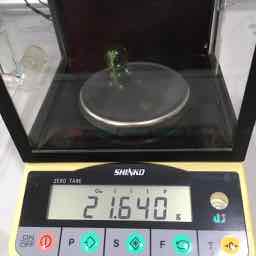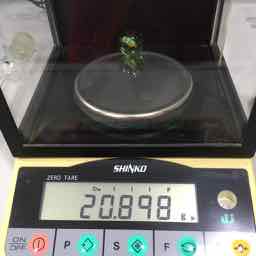Class 22: Linear models
Computing in Molecular Biology and Genetics 1
Andrés Aravena, PhD
28 December 2020
Why?
Why are we here?
To become Scientists
Someone who does Science
Science is not only making experiments
Science is the process of creating knowledge
We search for truth with the Scientific Method
Scientific Method
- We observe the nature and find patterns
- We create models that can explain the patterns
- We make experiments to test if the models are valid
This way we avoid fooling ourselves
Scientist look for the truth
- Does smoking causes cancer?
- Does eating sugar makes you fat?
- Does your cellphone produce brain cancer?
- Will an expensive medicine cure your sickness?
The society expect from us, the scientists, to answer these questions with the truth
Even in everyday jobs
Tomorrow you may work in a blood bank.
Is the blood safe?
Or in a food factory.
Is the food safe? Is it GMO?
Or in a University.
Is this pharmaceutical company telling the truth?
Or you do a paternity test.
Is this person the real father?
Truth is essential for scientists
- Sometimes your experiments fail
- Sometimes you get a wrong result
- Sometimes your model is incomplete
- Most models are incomplete, and we are always updating them
You can be wrong, but you cannot lie
The Scientific Method
Some key parts of the Scientific Method
Models are tested with experiments
To be valid, experiments must be replicable
- That is, other people doing the same experiment must get the same result
There may be some variation between experiments
- You must declare what is your margin of error
- Every measurement has a margin of error
Doing Science with our data
We load the data
library(readr)
students <- read_tsv("students2018-2020-tidy.tsv",
col_types = cols(
sex = col_factor(levels = c("Male", "Female")),
handedness = col_factor(levels = c("Left", "Right"))
)
)
students# A tibble: 117 x 10
answer_date id english_level sex birthdate birthplace height_cm
<date> <chr> <chr> <fct> <date> <chr> <dbl>
1 2018-09-17 3e50… I can speak … Male 1993-02-01 -/Turkey 179
2 2018-09-17 479d… I can unders… Fema… 1998-05-21 Kahramanm… 168
3 2018-09-17 39df… I can read a… Fema… 1998-01-18 Batman/Tu… NA
4 2018-09-17 d2b0… I can read a… Male 1998-08-29 Antalya/T… 170
5 2018-09-17 f22b… I can read a… Fema… 1998-05-03 Izmir/Tur… 162
6 2018-09-17 849c… İngilizce bi… Fema… 1995-10-09 Yalova/Tu… 167
7 2018-09-17 8381… I can speak … Fema… 1997-09-19 Adıyaman/… 174
8 2018-09-17 b0dd… I can read a… Male 1997-11-27 Bursa/Tur… 180
9 2018-09-17 2972… I can read a… Fema… 1999-01-02 Istanbul/… 162
10 2018-09-17 72c0… I can read a… Fema… 1998-10-02 Istanbul/… 172
# … with 107 more rows, and 3 more variables: weight_kg <dbl>,
# handedness <fct>, hand_span <dbl>Plotting a formula
Reminder of plot() function
plot(y ~ x)looks likeplot(x, y)- Formulas are nice:
plot(y~x, data=dframe)
- In general the defaults are good
- axis labels are the plotted variable’s names
- ranges are automatic
- You can choose the horizontal and vertical ranges
Linear models
In science we work by creating models of how nature works
There are several kinds of models
One of the easiest and more commonly used are the linear models
We approximate all our data by a straight line that shows the relationship between some variables, with a formula like \[y=a + b\cdot x\]
A simple model
We want to describe the relationship between weight and height
A basic rule of thumb is that weight in kg is usually equal to height in cm minus 100 \[weight = height - 100\]
That is, the weight is the number of centimeters over one meter
Adding a straight line to a plot
A-B-line
This command adds a straight line in a specific position
abline(h=1)adds a horizontal line in 1abline(v=2)adds a vertical line in 2abline(a=3, b=4)adds an \(a +b\cdot x\) line
Linear models
Deciding the model formula
The hard part is to decide
- What is the dependent variable
- The values that we want to predict
- The vertical axis
- What are the independent variables
- The values that we can control
- The horizontal axis
- What is the formula connecting them
Our model
Here we are using a linear model \[y=a + b\cdot x\] more precisely \[weight = a + b\cdot height\]
Which are the best \(a\) and \(b\) values?
Finding the best line
We draw the figure using a formula
Using the same formula we can get a linear model
Call:
lm(formula = weight_kg ~ height_cm, data = students)
Coefficients:
(Intercept) height_cm
-84.0079 0.8822 Drawing the tendency line
We draw using abline() with the coefficients of lm()
Making the computer work for us
We must avoid copying data manually or using fixed values
Call:
lm(formula = weight_kg ~ height_cm, data = students)
Coefficients:
(Intercept) height_cm
-84.0079 0.8822 The useful part are the coefficients
(Intercept) height_cm
-84.007888 0.882157 The formula is \(y=a + b\cdot x\)
\(a\) is
coef(model)[1]\(b\) is
coef(model)[2]
Drawing the tendency line
plot(weight_kg ~ height_cm, data=students)
model <- lm(weight_kg ~ height_cm, data=students)
abline(a=coef(model)[1], b=coef(model)[2])Easily drawing the tendency line
plot(weight_kg ~ height_cm, data=students)
model <- lm(weight_kg ~ height_cm, data=students)
abline(model)Predicting with the model
Beyond giving a description of the data, models are often used to get a prediction of what would be the output of the system when we have new data
In this case we need to provide a data.frame with at least one column. The column name must be the same as the one used to create the model. For example
Predicting with the model
model <- lm(weight_kg ~ height_cm, data=students)
guess <- predict(model, newdata=data.frame(height_cm=155:205))An experiment
Coils and Rubber bands
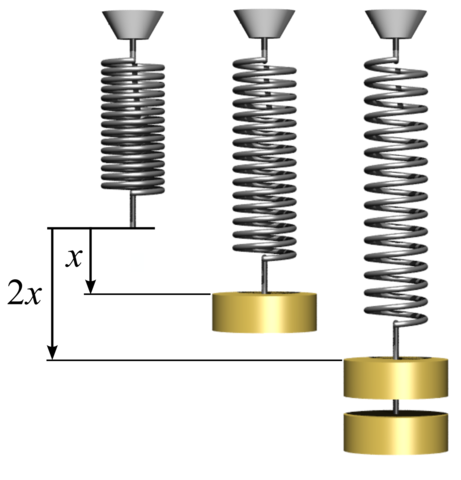
- Coils and rubber bands have a natural size
- If you apply a force to them, they expand
- What is the relation between the expansion and the force?
Robert Hooke said it first
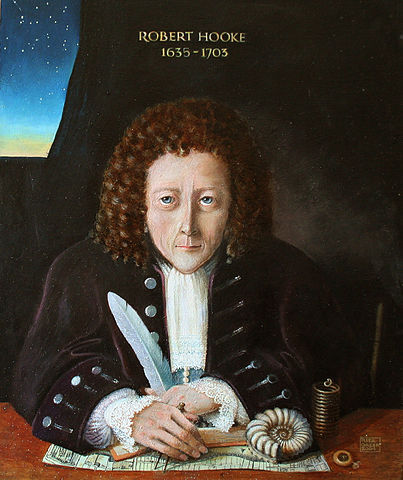
In 1660, Hooke discovered the law of elasticity which describes the linear variation of tension with extension
“The extension is proportional to the force”
Robert Hooke
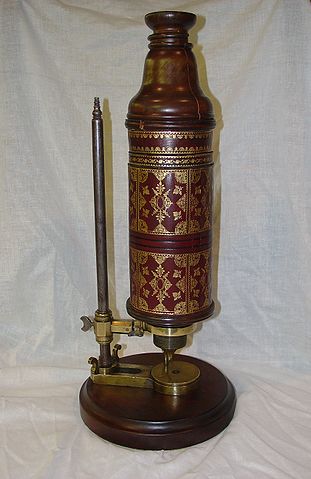 Natural philosophy was the study of nature and the physical universe that was dominant before the development of modern science
Natural philosophy was the study of nature and the physical universe that was dominant before the development of modern science
Polymath (from Greek “having learned much”) is a person whose expertise spans a significant number of different subject areas
Biologist. Hooke used the microscope and was the fists to use the term cell for describing biological organisms.
How do we model a coil?
The essence of the coil is:
- It has a natural length \(L\)
- If we change the length by \(x\), it pulls with a force \[\mathrm{force}(x)= K \cdot (L-x)\]
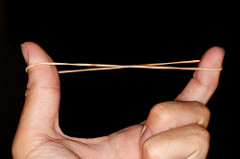
Doing the experiment





Results
| n_balls | length | repetition |
|---|---|---|
| 0 | 78.00 | 1 |
| 1 | 82.61 | 1 |
| 2 | 85.85 | 1 |
| 3 | 90.26 | 1 |
| 4 | 95.05 | 1 |
| 0 | 79.21 | 2 |
| 2 | 85.55 | 2 |
| 3 | 90.06 | 2 |
| 4 | 94.35 | 2 |
(some data omitted from the table. Get all data at
http://dry-lab.org/static/2017/rubber1.txt)
Graphic Results
Best-fit line
When data seems to be in a straight line, we can find that line
The best-fitting line is found using a linear model
Call:
lm(formula = length ~ n_balls, data = rubber)
Coefficients:
(Intercept) n_balls
76.48 5.06 What are the coefficients?
Remember that straight lines can be represented by the formula \[\text{n_marbles}=A+B\cdot \text{length}\] The coefficient \(A\) is the value where the line intercepts the vertical axis
The coefficient \(B\) is how much length goes up when n_marbles increases. This is called slope
Physical interpretation of the linear model
The formula from Hooke’s Law is \[\text{force}=K\cdot(L-\text{height})\] Since force is the weight of the balls, we can write \[-m g\cdot\text{n_balls}=K\cdot(L-\text{lenght})\] which can be re-written as \[\text{lenght}=\underbrace{L}_{A}+\underbrace{\frac{m g}{K}}_{B}\cdot\text{n_balls}\]
Physical interpretation of coef(model)
When there are no balls, the length of the coil is \(L\), in this case
(Intercept)
76.48188 If the mass of each ball is 20gr, we can find \(K\) as
n_balls
25.81566 Marbles weight \(\approx 21\pm 0.5\) grams
